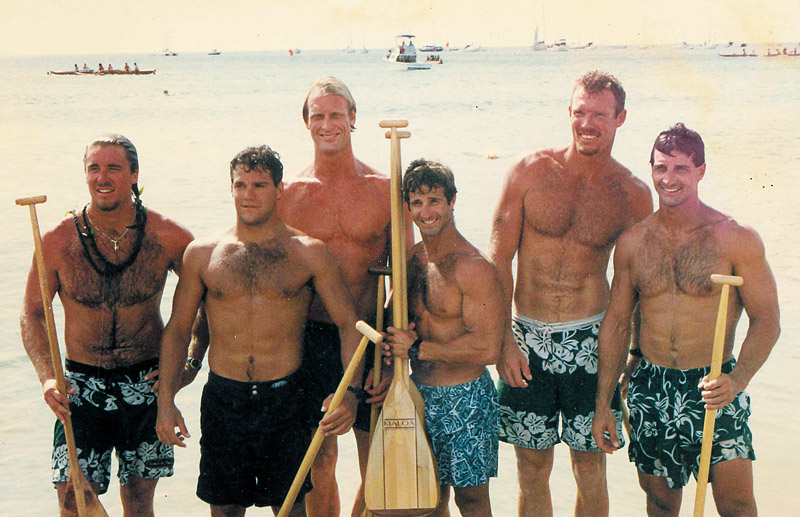Canoe Culture
Growing up in Lanikai, the ocean was John and Jim Foti’s playground — and it stlll is
Frank, John, Jim and Kathy Foti grew up with saltwater running through their veins, or at least it seemed that way.
The Foti children were raised just a stone’s throw away from Lanikai Beach, where paddling and surfing were part of everyday life. As far as they knew, the ocean was their playground and surfboards, paddles and canoes were their toys.
“You go down the beach and there’s Lanikai Canoe Club,” says Jim. “My brother John used to say, ‘Didn’t everybody grow up with a canoe club across the street from their home?'”
Dr. Philip Foti and wife Mollie introduced paddling to their children early in life. Philip even built a three-man plywood canoe for the family to enjoy. Who knew it would be a training vessel that would forever change Jim and John’s lives?
“I don’t even remember it, but I guess we all learned to steer in it,” laughs Jim. “Then, in 1975, we got our yellow four-man canoe. It was the best toy the family ever had!”
The sport was ingrained in the Foti children, especially young John and Jim. It didn’t take long for the world to learn the brothers had God-given talent.
“I was John’s wingman!” says Jim with great pride. “He was so good at what he did, and that’s why I enjoyed success, too. It wasn’t a choice. Yet, it wasn’t forced on us. We learned early that, ‘Hey, we’re pretty good at this!'”
Kanaka Ikaika is born
At about the same time, another paddler from Windward Oahu was busy being a pioneer. Dr. Dale Adams wanted to prove that a solo paddler could cross the treacherous and unpredictable Kaiwi Channel. In 1976, history was made when Adams completed the first known crossing from Molokai to Oahu in a kayak in just under eight hours.
“I was credited with winning the first race, but I was the only one in it so it wasn’t a race,” laughs Adams. “It wasn’t a race until the next year when we had three of us in it!”
The following year, Dean Hayward and Jorgen Hansen joined Adams on Molokai.
“When we appeared on Molokai with the first kayaks, people didn’t know what they were,” says Adams. “Nobody thought we could do it. It aroused suspicions that we were crazy and there was a lot of doubt, to say the least, that we could cross the channel.”
The trio took off near Ilio Point and raced across Kaiwi Channel, finishing at the bridge at Hawaii Kai. Hayward finished first, followed by Hansen and then Adams.
Thus, Kanaka Ikaika Racing Association (KIRA) officially was born.
In 1978, in the second annual Kanaka Ikaika Molokai to Oahu race, Kailua’s Kalai Handley finished first in a time of 5 hours and 35 minutes.
A year later, the event saw a huge increase in participation with 20 paddlers, including three one-man canoes (OC-1) paddled by Tommy Holmes, Dale Hope and Paul Gay.
Adams visualized great things for a racing series and came to the beach with what some considered out-of the-canoe ideas.

Hanalei 1995 — fastest mile split 6:41 — (from left) Bobby Nottage, Mike Pedersen, Bo Eastabrooks, Jim Foti, Rich Lambert and John Foti PHOTOS COURTESY FOTI FAMILY
“I wanted to model it after the Tour de France, and we would have a colored jersey for the winner leading the series, but people didn’t buy into that,” says the now-73-year-old Adams. “What we did agree on was making it a worldwide event. I envisioned it being successful. I would not have started if I didn’t have high hopes.”
High hopes, high goals, high success
OC-1s were taking the Pacific Ocean by storm. It seemed like every day someone was trading in a kayak for an OC-1. Jim remembers seeing one at the 1989 State Canoe Racing Championships that left a lasting impression.
“Walter Guild (Outrigger Canoe Club) came out with his first one-man,” he recalls. “The Horizon was about 26 feet long, straight and narrow. He’d been to Tahiti and had scoped out what was going on down there, and he busted it out at states. I said, ‘Oh, my god, this is the coolest thing since like sliced cheese!’ I had to get one!”
In 1992, Jim and John Foti joined the party — and the sport would never be the same.
“My brother and I bought a one-man with my mom,” recalls Jim. “It was $1,600 and we split it. I remember the first race was the Kalakaua Regatta. I pulled up at the starting line and looked around. I did that race and I won! I said, ‘Wow, really?'”
Jim would win the next race as well. Then he and his brother teamed to win the Kaiwi Relay.
“After that we said, ‘OK, we’re players in this,'” he says.
The Foti brothers dominated the local circuit, winning race after race after race. In 1993, there were about a dozen OC-1 races, and every week it seemed like a Foti was at the top of the leaderboard.
Karel Tresnak, a former Olympic whitewater canoe-ist from Czechoslovakia, who was coaching the men of Lanikai Canoe Club at the time, recognized the opportunity to raise his club to another level and jumped into the OC-1 building game in the mid-’90s.
“Karel thought it was a great training tool, and he was right, and that turned our program around,” says Jim. “We (Lanikai Canoe Club) went from barely winning to winning the Senior Men races at regattas and then the Molokai Hoe in 1995.”
It was the start of a historical winning streak of Senior Men victories that would span decades. Lanikai’s Molokai Hoe victory in ’95 was the first of five titles for the club, with Jim sitting in the steering seat in all five. He quickly had become the elite of the elite, amassing more victories in Hawaii than any other steersman in the history of the sport.
Double-edged sword
But with success came high expectations. While the victories were sweet, they came at a cost.
“The introduction of the OC-1s meant year-round paddling,” says Jim. “It was great for the club’s success, but it was also a double-edged sword. Once we got serious, we had to paddle year-round to stay at a high level. Next thing you know, you’re not surfing and you’re not playing soccer anymore. But there were no regrets. None!”
Jim not only was successful as a competitor on the Kanaka Ikaika circuit, he also was a sponsor.
“In the mid-’90s I got involved on the sponsor side while importing Hinano beer,” he says. “I saw it as a vessel to help promote what I was doing, and that would help me later understanding what a sponsor wants and needs.”
By the end of the ’90s, OC-1s eclipsed surf skis, and Lanikai Canoe Club was on top of the paddling world.
“Worldwide surf skis were still a bigger sport, but here in Hawaii, OC-1s took off,” says Jim. “They were closer to old Hawaiian canoes and also easier to start up on.”
But despite the OC-1’s growing popularity, KIRA race numbers were dropping. At one point, the organization was hanging on by a thread. From a 14-race series it had dwindled to only two events. The void opened holes in the schedule and other organizations sprung up to put on races. KIRA also had given away the crown jewel, the Molokai-to-Oahu solo race.
“It hit the skids for a few years; some would call it growing pains,” says Adams. “It was evolving as it should, that’s just the way things work, but it wasn’t evolving in the right way.”
Taking the steering blade and paddling forward
In 2010, Jim and wife Joey came back to the organization to lend a hand. They helped create new racecourses and started serving tasty lunches at post-race events.
They wanted to make a difference and they’d get that chance three years later, when they were offered the opportunity to steer the organization into the future.
“Everything goes in cycles, it ebbs and flows,” says Jim. “There’s not a lot of financial benefit for anybody running these things. You do it for the paddlers, and we wanted to give back to a sport that has given our family so much. Kanaka Ikaika was kind of waning there for a period, and a lot of races were abandoned.”
Jim wanted to change that and focused on increasing sponsor support for KIRA, with a goal of offering more quality events. They started the restructuring by converting the organization to a 501(c) (3) so it could accept tax-deductible donations, grants and sponsorships.
They also brought back the Molokai-to-Oahu solo race.
“Molokai is on everyone’s bucket list — it’s the jewel of all races and it’s so prestigious,” says Jim. “It’s still important. Our first goal was to right the ship and bring in more support. We knew we couldn’t do it without sponsors.”
The owner of Scott Hawaii was the first to respond.
“They didn’t hesitate,” recalls Jim. “They jumped right in and said, ‘How can we help the sport and help you guys?'”
They also rebranded KIRA’s logo and opened up races to other paddling disciplines.
“How can you deny the popularity of stand-up paddling (SUP) and lay-down paddleboarding?” he says. “We really encouraged it, which brought in another big sponsor, Maui Jim!”
The moves resulted in more races and an increase in exposure and credibility in the water sports community. Kanaka Ikaika now offers prize money, and, for the first time ever, television coverage.
“Since Jim and his wife have taken it over, they’ve been putting on a great show,” says Adams.
“Joey is my rock and there’s no way I can do all this alone,” says Jim. “I’m out there on the surface talking to sponsors and doing interviews, but it takes a team and a solid one at the top. She’s at the top.”
Jim says his wife also has brought refreshing ideas to the table, as well, creating a special event for women only.
“Na Wahine Ikaika had 130 women lining up at the starting line last year,” says Jim. “When the women looked to the right, left and behind them, they saw only women. It was a huge success and it’s only going to get bigger and better.
“She’s the wind beneath my wings!”
Celebrating 40 years that started with a dream
On May 29, Kanaka Ikaika will celebrate 40 years since Adams’ first kayak crossing from Molokai to Oahu. Maui Jim Molokai Challenge has increased the OC-1 purse to make the 2016 prize money equal to the surf skis’ — $2,000 for first place in both surf ski solo and OC-1 solo across the line.
Ocean Paddler TV will provide race coverage. Jim encourages everyone to follow it on Facebook at Ocean-PaddlerTV, on Vimeo.com or through OC-16 at oc16.tv.
“Dr. Adams wanted to conquer the channel alone and went out there with a dream and made it happen,” he says. “What he did and all those behind him who kept it together through thick and thin, ups and downs, and today it’s still a gem! The process has been a real challenge, but we are looking toward the future and are here to take the torch for the next generation of paddlers. We believe we have set KIRA on a course that will keep it vital for years to come!”
It helps when one of the world’s greatest steersmen of all time is charting the course. The story keeps growing.
For more information on the organization, visit kanakaikaika.com.










